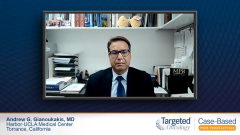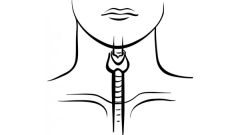
Systemic Therapy for RAI-Refractory DTC
Episodes in this series

Andrew G. Gianoukakis, MD: Systemic therapy, ideally, should be used in patients with radioiodine-refractory progressive disease when the disease is becoming symptomatic or symptoms are impending. For example, lung lesions that have grown in number and size to the point where they will affect lung function, critical neck lesions that are not candidates for surgical resection and present a risk for invading structures in the neck, or paraspinal lesions that are critical and at risk with additional progression of causing nerve symptomatology. We need to use these drugs because, although they are not a cure, they control disease when disease is progressing and when patients are at risk of symptomatology or morbidity.
In the case described, this is an older woman who could be treated with systemic therapy. However, she is asymptomatic and her lung lesions are small. In thyroid cancer, unlike other cancers, even metastatic lesions can remain stable and nonprogressing for many years. It’s possible that this patient can be followed for multiple years without significant progression that leads to symptoms or the need to intervene. Since the drugs stabilize disease, are not a cure, and have [adverse] effects that can be troublesome in the older population, in the case described we definitely want to have an active surveillance watch-and-wait approach. We want to follow the patient’s lung lesions and thyroglobulin level, and intervene prior to symptoms or to morbidity development. But at this point, the patient remains asymptomatic and has small lung lesions that are inconsequential to the patient and her state of well-being.
The NCCN [National Comprehensive Cancer Network] guidelines have both sorafenib and lenvatinib listed, although there is a stated preference for lenvatinib if all other issues, including comorbidities, are equal. This is likely due to the greater efficacy noted with lenvatinib treatment. Comorbidities can potentially be considered when choosing between these 2 medications. Similarly, the toxicity profile can be considered. It’s notable that patients with sorafenib suffer from hand-foot syndrome at a much greater degree than patients taking lenvatinib. On the reverse side, patients with lenvatinib suffer from hypertension to a greater degree than patients with sorafenib. These are comorbidities and subsequent toxicities that can be considered when initiating therapy.
Furthermore, we do know that lenvatinib is effective as second-line therapy after treatment with sorafenib. Therefore, we have greater confidence that lenvatinib can work as second-line therapy. Personally, I do not initiate sorafenib followed by lenvatinib because lenvatinib’s efficacy is so much greater than sorafenib’s. Unless noted to have a real good reason to initiate sorafenib, I proceed with lenvatinib as first-line therapy in most cases.
Transcript edited for clarity.
Case: A 73-Year-Old Woman With Differentiated Thyroid Cancer
Initial Presentation
- A 73-year-old woman complains of a “lump” on her neck, with occasional swelling and dysphagia
- PMH: obese; BMI 32
- PE: palpable, nontender neck mass
Clinical Work-up and Initial Treatment
- Labs: TSH 1.1 µU/mL; all others WNL
- Ultrasound of the neck revealed a 3.0 cm mass in the right lobe of the thyroid; several suspicious lymph nodes ranging from 0.2-3.0 cm in size
- Ultrasound-guided FNAB: confirmed papillary thyroid carcinoma
- Patient underwent total thyroidectomy with bilateral central neck dissection
- Pathology: 3.0 cm papillary thyroid cancer arising in right lobe of the thyroid, 2 of 5 positive central compartment lymph nodes, largest 1.4 cm, positive extra nodal extension
- StageT2N1MX; ECOG PS 0
Subsequent Treatment and Follow-up
- She was treated with radioactive iodine
- Levothyroxine to suppression was added to treatment regimen
- Follow-up at 6 months TSH 0.4 µU/mL, thyroglobulin 4 ng/mL
- Neck US unremarkable
- Follow-up 12 months TSH 0.3 µU/mL, thyroglobulin 18 ng/mL
- US of the neck was unremarkable
- CT of the chest showed 10 lung nodules, largest 1.2 cm in size
- Administered radioactive iodine 150 millicuries
- Post therapy scan showed no lung or other uptake
- Follow-up at 2 years TSH 0.3 µU/mL, thyroglobulin 30 ng/mL
- Chest CT increasing number and size of lung nodules; largest 1.6 cm
- Patient was asymptomatic and deemed radioactive iodine refractory
- Systemic therapy with lenvatinib 24 mg PO qDay considered









































